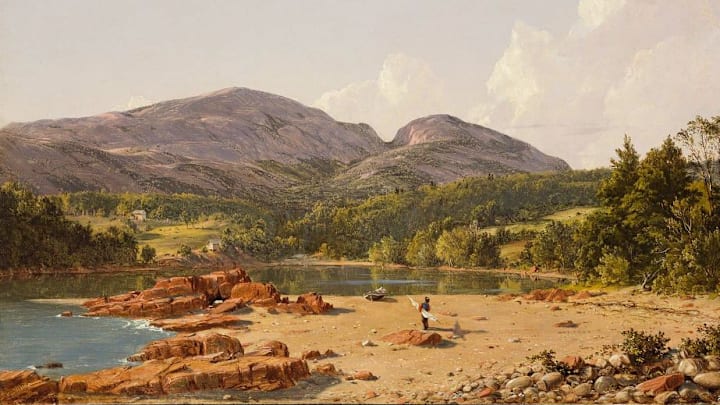Coastal Maine’s Acadia National Park is one of the most visited national parks in the United States, drawing almost 4 million visitors in 2024. Acadia is also one of the oldest national parks; it was established in 1919 under the name Lafayette National Park. It wasn’t until 10 years later that it was renamed Acadia, which is thought to have originally come from the native Mi’kmaq name for the land, akadie or cadie, and was rendered as l’Acadie by French settlers.
But Acadia’s popularity predates its designation as a national park, with the scenic area being put on the map thanks to first being put on the canvas by a group of painters during the mid-1800s.
As Pretty as a Picture
Acadia National Park stretches across Mount Desert Island, as well as parts of Isle au Haut and the Schoodic Peninsula. The lush forest and rugged mountains—including 1527-foot tall Cadillac Mountain, the highest peak on the eastern seaboard—have been drawing people in for centuries, with evidence of Native Americans living on the land at least 5000 years ago. French explorers and settlers started to arrive in the early 1600s and they were soon followed by English colonizers. By the start of the 19th century, a large settler community had been firmly established.

But word of the area’s beauty didn’t get out on a national scale until artists started visiting during the mid-1800s. Although Thomas Doughty painted the striking region in the 1830s, it was Thomas Cole—founder of the Hudson River School, a group of artists with a deep reverence for nature—who really paved the artistic way. Cole visited Mount Desert Island in 1844; his paintings of the dramatic scenery inspired his student, Frederic Edwin Church, to follow in his footsteps. Cole and Church’s artistic renditions of the picturesque landscape then inspired other artists—including Sanford Robinson Gifford, Clement Drew, and Julia Whiting—to head to Maine’s coast to paint the area for themselves.

While others sought to tame and industrialize the American wilderness, these artists wanted to celebrate the country’s pristine scenery. After seeing a landscape art exhibition in 1847, one reviewer neatly summed up the mission of the painters: “Yankee enterprise has little sympathy with the picturesque, and it behooves our artists to rescue from its grasp the little that is left before it is forever too late.” The paintings of Mount Desert Island that were displayed in galleries and at exhibitions in big cities—including New York, Boston, and Philadelphia—helped to achieve this goal. They helped inspire people to visit (and later protect) the then relatively unknown area.
Mount Desert Island was then given another boost in popularity thanks to Clara Barnes Martin, who published the area’s first guidebook in 1867. The guide went through six editions as more and more people flocked to Maine’s rugged coastline to see its wild beauty with their own eyes.
The Creation of a National Park
There was no tourist industry in the area when the artists were putting paintbrush to canvas, so they stayed in the homes of local farmers and fishermen for a small fee. But after their paintings and Martin’s guidebook made the area known to the wider public, the village of Bar Harbor was developed, serving as a launching point for tourists looking to explore. By 1880, there were 30 hotels for tourists to choose from. In just a couple of decades, Mount Desert Island had gone from a largely unknown section of the States to a much sought-out adventurer’s paradise.

With Mount Desert Island now on the map, the wealthy visitors who summered there year after year—including the Rockefellers—set out to protect the pristine landscape. George B. Dorr spearheaded the campaign, donating his own land to the government and convincing other wealthy owners to turn over their acres. In 1916, President Woodrow Wilson established the precursor of Acadia—known as Sieur de Monts National Monument—before the area gained national park status three years later. Dorr was the park’s first custodian and became known as “the father of Acadia.”

Acadia’s artistic history lives on not only in the 19th century paintings, but also in the form of the Artist-in-Residence Program. Since 1993, Acadia has hosted more than 100 artists—from painters and writers to sculptors and musicians—all looking to take inspiration from Maine’s natural beauty, just like the 19th century artists before them who originally put Acadia in the spotlight.
Read More About National Parks:
